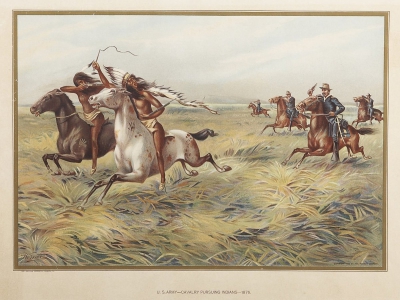The Grattan Massacre, also known as the Grattan Fight, was the opening engagement of the First Sioux War, fought between United States Army and Lakota Sioux warriors on August 19, 1854. It occurred east of Fort Laramie, Nebraska Territory, in present-day Goshen County, Wyoming.
A small detachment of soldiers entered a large Sioux encampment to arrest a man accused of taking a migrant's cow, although such matters by treaty were to be handled by the US Indian Agent. After one of the soldiers fatally shot Chief Mat Wayhi (Conquering Bear), the Brul Lakotas returned fire and killed a total of 29 soldiers, Lieutenant John Grattan, and a civilian interpreter. The massacre, as it was called by the American press, is considered an early and significant event in the Plains Indian Wars.
The American Indian Wars, also known as the American Frontier Wars, the First Nations Wars in Canada (French: Guerres des Premières Nations), and the Indian Wars, were fought by European governments and colonists in North America, and later by the United States and Canadian governments and American and Canadian settlers, against various American Indian and First Nation tribes. These conflicts occurred in North America from the time of the earliest colonial settlements in the 17th century until the early 20th century. The various wars resulted from a wide variety of factors. The European powers and their colonies also enlisted allied Indian tribes to help them conduct warfare against each other's colonial settlements. After the American Revolution, many conflicts were local to specific states or regions and frequently involved disputes over land use; some entailed cycles of violent reprisal.
As settlers spread westward across North America after 1780, armed conflicts increased in size, duration, and intensity between settlers and various Indian and First Nation tribes. The climax came in the War of 1812, when major Indian coalitions in the Midwest and the South fought against the United States and lost. Conflict with settlers became much less common and was usually resolved by treaty, often through sale or exchange of territory between the federal government and specific tribes. The Indian Removal Act of 1830 authorized the American government to enforce Indian removal from east of the Mississippi River to Indian Territory west on the American frontier, especially what became Oklahoma. The federal policy of removal was eventually refined in the West, as American settlers kept expanding their territories, to relocate Indian tribes to reservations.

1855Sep, 3
American Indian Wars: In Nebraska, 700 soldiers under United States General William S. Harney avenge the Grattan massacre by attacking a Sioux village and killing 100 men, women and children.
Choose Another Date
Events on 1855
- 14Feb
Telegraphy
Texas is linked by telegraph to the rest of the United States, with the completion of a connection between New Orleans and Marshall, Texas. - 22Feb
State College, Pennsylvania
The Pennsylvania State University is founded in State College, Pennsylvania (as the Farmers' High School of Pennsylvania). - 1Jun
William Walker (filibuster)
The American adventurer William Walker conquers Nicaragua. - 4Jul
Leaves of Grass
The first edition of Walt Whitman's book of poems, Leaves of Grass, is published In Brooklyn. - 16Nov
Victoria Falls
David Livingstone becomes the first European to see the Victoria Falls in what is now Zambia-Zimbabwe.

 English
English  español
español  français
français  português
português  русский
русский  العربية
العربية  简体中文
简体中文 